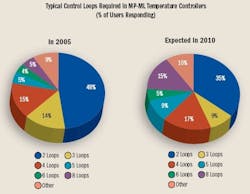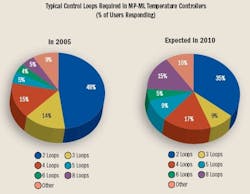Temperature controller users prefer more loops
Among users controlling temperature loops with microprocessor-based, multiple-loop (MP-ML) controllers, more are buying the devices with more control loops. Though they’re purchasing more costly MP-ML controllers, users can control more complex processes and more equipment with fewer controllers.
In its survey of end users, OEMs and systems integrators, VDC found the purchasers of MP-ML temperature controllers chose two-loop MP-ML controllers most often, and project this will remain the case, but at a lower percentage share. For a significant share of the survey respondents, the most typical deployment of control loops will shift to four or more, with the largest gain expected for eight-loop controllers.
To meet this shifting market demand, the study adds MP-ML suppliers offer modular products made up of two and four-loop controllers, from which they form units with eight or more loops. These can be less expensive to produce than manufacturing separate eight and eight-plus loop controllers. These also have the added attractiveness of providing easy expansion. VDC says many users already purchase modular MP-ML controllers, and expects more to follow in the future.


